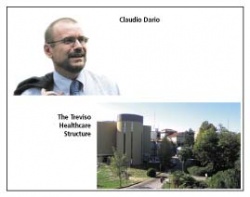Telemedical co-operations
Italy Spain Denmark Belgium

When Claudio Dario, the CEO of Treviso Healthcare Structure, decided to take his hospital departments into the 21st century by experimenting with telemedicine applications he brought about huge improvements for providers and users alike.
In 2003, Escape, the first telemedical project - later extended and renamed TelemedEscape - was up and running in Treviso Healthcare Structure, and it has since been adopted by other Italian healthcare divisions in other regions to provide a service for three million potential users.
This completely digital system of signing, transmitting, delivering and storing clinical documents, maintaining the privacy and the security of healthcare data, brings big healthcare delivery advantages, including the fact that patients can read their results on the internet (35% of patients now download results) or by post (11% receive results directly at home).
The Health Optimum Project - Closely connected to TelemedEscape, this is interdisciplinary, with clinical partners from Italy’s Veneto Region, Spain’s Aragon Government, and Denmark’s County of Funen, and with technological assistance and support provided by the Partners Telemedicina Rizzoli (Italy), and TB Solutions Technology Software S.L. (Spain), organisational assistance and support by PriceWaterhouseCoopers (Italy), and the Project Manager is Health Information Management (Belgium). It is approved and co-funded (budget Ä 2,200,000,00) by the European Community within the eTEN programme.
Health Optimum is validating the re-engineering of healthcare delivery via telemedicine - tele-counselling, tele-laboratory, virtual referral, tele-care and shared clinical data. It aims to re-organise processes, standardise clinical and technological procedures and manage patient documentation digitally.
A wide variety of specialties have been tested in this project, namely neurosurgical tele-counselling and tele-laboratory in Veneto, tele-diabetes, tele-cardiology in Funen and tele-haematology, tele-radiology, tele-oncology, tele-endocrinology, tele-nephrology, tele-cardiology and tele-laboratory in Aragon. At the root of these tele-counselling initiatives lies the need to provide prompt consultancy by specialists for urgent medical cases and also to provide services for citizens living in hard-to-reach, remote areas.
During a tele-consultation an emergency department specialist, using a digitally signed electronic request containing all necessary clinical data and images, asks a tertiary hospital specialist for an opinion, and that centre of excellence sends back a digitally signed opinion. An addition specialist in the circuit can also be consulted, for example one on duty in another tertiary hospital, or the Head of a Department who, through a remote connection, can view the data even from home.
For the Tele-laboratory applications a new generation of instruments allowing tests to be carried out onsite and to show the results immediately at the patient’s side, make for a simplified workflow and cost reduction. The system is based on a palm-size device (POCT - Point of Care Testing), which interacts with a portable PC equipped with a specific software application. Test results collected on the spot can later be uploaded onto the hospital server for certification by the laboratory using a digital signature.
The clinical partners are presently working on field trials and collecting results. A preliminary market survey has been carried out and also a Business Plan has been drafted based on the ex-ante situation and with the results of the field trials, it is being constantly refined. A quality of care impact assessment is also underway to compare ex-ante and ex-post indicators.
Begun in May 2004, the Health Optimum project should be completed in January 2006, with an important final conference taking place in Palazzo Franchetti, Venice. There, internationally renowned telemedicine experts, present either physically or virtually, will participate in discussions, see the illustrations of H.O. applications and demonstrations of the telemedicine services.
A newly founded Telemedicine Observatory Consortium is to be launched at the event. Nineteen Veneto Healthcare Structures, covering a population of about 3.5 million people, voluntarily worked together to draw up its constitution. Among its aims is to share tele-medical know-how and to reproduce and adapt best practices to medical-legal organisational standards and international technological standards.
02.08.2006










